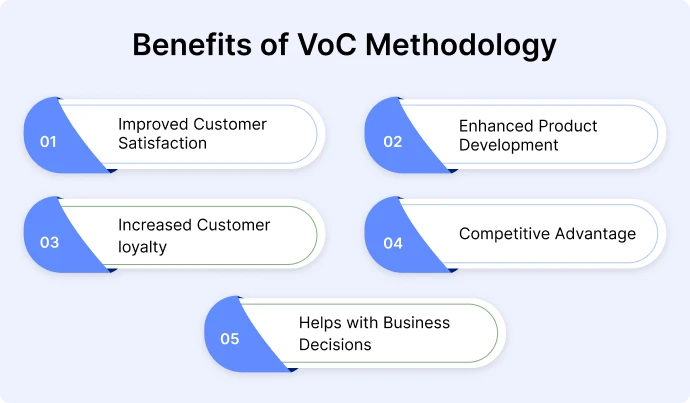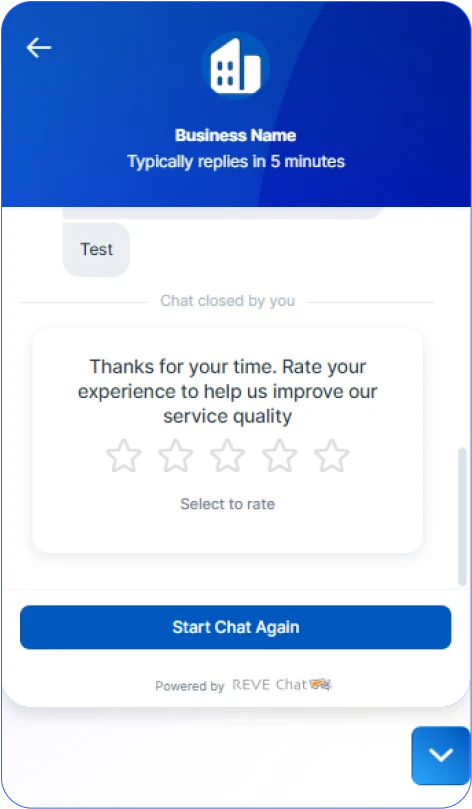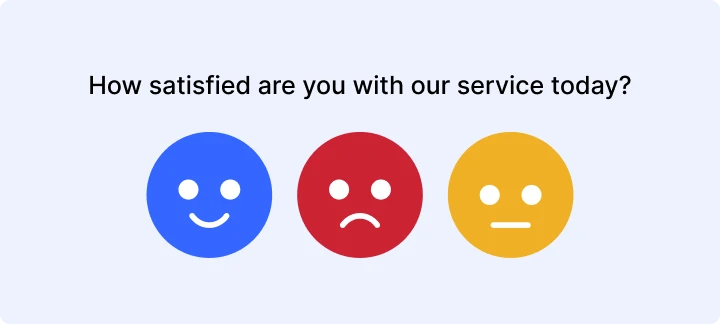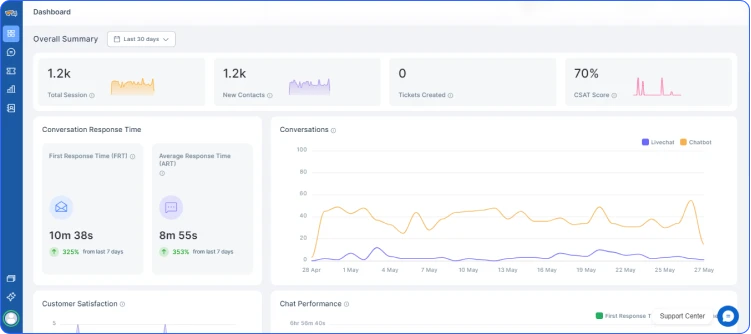13 Voice of the Customer Methodologies to Generate Customer Feedback
- May 27, 2024
- 21 mins read
- Listen
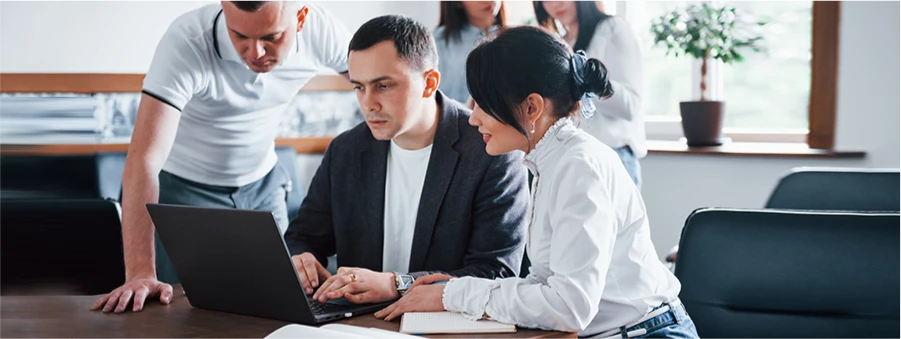
Table of Content
In your business, you need information about your customers’ pain points, preferences, requirements, and most importantly their feedback.
Now think this way- to know about them, you need customer data. There can be two options. You either have mountains of data about your customers or barely any at all. Regardless of any such scenario, you’re left grappling with the same challenge—you will not get meaningful, actionable insights. Sounds scary? Dont worry. Why don’t you ask your customers directly? Well, welcome to the world of Voice of the Customer (VoC) methodology.
Successful companies create products that cater to customer needs, offer outstanding service, and tailor various sales and marketing strategies to send valuable messages. To excel in these areas, you must need deep insights into your customer base. While demographic data and general market research provide some clues, they fall short of revealing what your specific customers think about your company or what they truly need.
This is where voice of the customer programs shine. By gathering targeted feedback directly from your customers, these VoC programs help businesses enhance customer experiences, uncover new trends and opportunities, and of course boost sales. Sounds interesting? Let’s read more to understand what VoC programs are all about and how you can implement one successfully.
What is the Voice of the Customer?
Voice of the Customer (VoC) is precisely what it sounds like: paying attention to your customers. But here is one proper definition for you!
The Voice of the Customer (VoC) is a structured approach aimed at capturing customers’ needs, requirements, and perceptions about your product offerings.
VoC methods involves collecting and analyzing customer feedback to directly enhance products and customer experiences. This approach ensures that customer responses are not only heard but are also used as a driving force for continuous improvement and innovation.
What is Voice of the Customer Methodology?
Voice of the Customer (VoC) methodology is a structured approach used to gather and analyze customer feedback.
VoC methodology involves various techniques such as surveys, interviews, focus groups, and social media monitoring to collect both quantitative and qualitative data, ensuring a comprehensive understanding of the customer experience.
The famous online knowledge resource platform Business2Community released an article highlighting how companies can achieve significant results by implementing Voice of Customer strategies such as:
- A tenfold increase in annual revenue year-over-year
- 55% higher customer retention rates
- A 23% reduction in yearly customer service costs
- A 292% boost in employee engagement rates
Importance of Voice of the Customer Methodology
Up to 86% of consumers are ready to pay more for an enhanced customer experience. So, how can you ensure they receive it? The answer lies in your customer feedback. Let’s explore how implementing a Voice of Customer (VoC) program can significantly benefit your company.
- Improved Customer Satisfaction: By listening to and acting on customer feedback, businesses can tailor their products and services to better meet customer needs, leading to higher satisfaction levels.
- Enhanced Product and Service Development: Customer insights gained through the voice of the customer programs can guide the development and improvement of products and services, ensuring they align with the latest market demands and customer expectations.
- Increased Customer loyalty: Understanding your customers’ pain points, choices, and needs allows you to cater to them better, which boosts their experience and strengthens their loyalty to your business. This, in turn, will give you increased sales conversions.
- Competitive Advantage: Companies that effectively use VoC can differentiate themselves from competitors by consistently delivering superior customer experiences.
- Helps with Business Decisions: Before launching a new product, service, or idea, you can test it through the different voices of the customer programs to see whether customers are interested in the new product line or if it will be profitable. If the idea isn’t good, you can instead focus on what customers actually want.
Voice of the Customer Methods
The best way to gather the voice of the customer feedback depends on what you want to achieve, your budget, and your team’s capability. Here are several methods to gather valuable insights directly from your customers.
1. Live Chat
More than 41% of customers currently anticipate live chat availability on websites, valuing its immediate interaction advantages.
Live chat is a valuable tool that enables customers to connect with your business in real-time and provide feedback on your organization, products, or any issues they encounter. You can configure live chat to automatically pop up in response to specific customer actions, such as spending too much time on the website, and offering timely assistance when needed.
The live chat tools also allow you to conduct pre-chat surveys, gather valuable insights before the conversation even begins, get instant customer feedback after ending any live chat session, and measure important KPIs. This feedback can then be used to enhance your website or improve your offerings, ensuring a better overall customer experience.
Best live chat tools:
- REVE Chat
- Zendesk
- Olark
- LiveChat
- Pure Chat
2. Customer Surveys and Questionnaires
Surveys and questionnaires are widely used VoC methods. They can be distributed online, via email, or in person and cover a broad range of topics, from customer satisfaction to product feedback. Make sure your questions are clear and concise to obtain accurate responses.
Best VoC survey tools:
- SurveyMonkey
- HubSpot Forms
- Medallia
- Qualtrics
3. Social Media Monitoring
Monitoring social media platforms like Facebook, Instagram or Twitter lets you see what customers are saying about your brand in real-time. Tools like social listening software can help track mentions, sentiments, and trends, providing immediate and actionable feedback.
While this method is effective for gathering feedback, identifying trends, and creating narratives, it can be more challenging to convert this into quantitative data. However, the advantage is that you receive unfiltered feedback directly from your customers.
Best social media monitoring tools:
- Hootsuite
- Sprout Social
- Buffer
- Mention
- BuzzSumo
4. Net Promoter Score
Net Promoter Score (NPS) is a tool used to measure customer loyalty. Created by Fred Reichheld, Bain & Company, and Satmetrix Systems, NPS understands customer sentiment by asking a simple question: “How likely are you to recommend our business to others?” This straightforward question helps your business understand overall customer satisfaction and loyalty, providing valuable insights into your customer relationships.
Useful tools for calculating NPS:
- Hotjar
- HubSpot
- AskNicely
- SurveyMonkey
- Satmetrix
5. Customer Interviews
Interviews are another good voice of customer methods of collecting customer feedback, alongside focus groups and surveys. They can be conducted via email, phone, or in person. Many customers appreciate interviews, seeing them as an easy way to build trust and strengthen their relationship with the brand. This approach allows for follow-up questions and deeper exploration of specific issues, providing qualitative data that uncovers underlying problems if any, and motivations.
6. Monitoring Website Behaviour
Your website serves as an excellent platform for conducting voice-of-the-customer research. In addition to using live chat and online surveys, you can gather valuable insights by analyzing customer behavior on your site. By pinpointing navigation obstacles, you can enhance the overall user experience (UX).
Leveraging website feedback tools such as Google Analytics provides comprehensive traffic analysis, measures bounce rates, and offers features like heatmaps and scroll maps. These tools enable you to track user behavior at every stage of the customer journey, identify where users drop off, and optimize the online customer experience accordingly.
Best website monitoring tools:
- Google Analytics
- Inspectlet
- CrazyEgg
- Pingdom
- GTmetrix
7. Focus Groups
Focus groups are gatherings where customers engage in in-person discussions, guided by a facilitator, to share their expectations and experiences openly. These sessions play a vital role in the exploratory voice of customer research, offering a comprehensive understanding of customer sentiment and the underlying reasons behind their opinions.
The qualitative data obtained in focus groups is often unstructured, making it more difficult to analyze compared to data gathered from online surveys. So you need to record these sessions to create transcripts that can be used for voice of customer analysis.
Best tools for focus groups:
- Tint
- FocusVision
- MonkeyLearn
- Voxco
- FocusGroupsIt
8. Online Customer Reviews
Studies reveal that a whopping 90% of consumers check reviews prior to making retail purchases, with 72% referring to multiple reviews. Remember one thing! Customers write online reviews when they are extremely satisfied or deeply dissatisfied. Both types of reviews offer valuable insights into customer loyalty and preferences. So, it is advisable to get your business verified on Google and maintain an active social media presence.
Although online reviews may seem daunting, they help a lot in your voice of customer research. Platforms like G2 Crowd, Finances Online, TrustRadius, and Capterra allow businesses to collect VoC insights without the need to individually approach customers.
After collecting online customer reviews, you can:
- Identify common themes and sentiments across different reviews to understand customer preferences, pain points, and areas for improvement.
- Compare your business’s performance against competitors or industry standards.
- Respond to reviews, both positive and negative.
- Use the insights gained from reviews to make informed decisions.
- Continuously track and analyze reviews.
9. Emails and Recorded Phone Calls
Every customer interaction, whether it’s a simple support call, product demo, or sales pitch, contains valuable insights. Conversations through sales emails or customer support calls highlight key concerns customers have when they are closely examining or using your products. By running text analytics on transcripts from these emails and recorded calls, you can decode the voice of the customer in their own words. Recorded calls and emails offer a comprehensive view of how customers perceive your brand, their opinions, and expectations of your company.
Getting detailed feedback from recorded customer support calls and emails can help in:
- Identifying common issues or pain points that customers experience with your product offerings.
- Providing targeted training and development opportunities to your teams.
- Identifying trends and patterns in customer behavior, preferences, and issues.
- Gathering insights on customer satisfaction levels.
10. In-Person Visits
Many times, you may visit customers to find out how they are liking your products or services. In networking events or other personal meetups in their own environments, ask customers about their opinions. Such personal visits help you to find out whether they are getting benefitted from your services or not.
How to proceed here? Here are some ideas for you:
- Through interactive sessions
- Workshops
- Group discussions
- Instore feedback
11. Online Feedback Forms
Well, this is not an option, rather it is a must to have for collecting VoC data. Collecting feedback through different online forms is a great scalable method to understand customer preferences, thoughts and pain points.
Make it a point to place feedback forms on important pages of your website. So that customer can share their feedback whenever they feel like. You must create those forms with to-the-point and relevant questions so that customers can provide answers that are actually valuable for your business.
Pro Tips:
- First, decide what you want to achieve by these feedback forms.
- Find out the key areas on which you need feedback from the customers.
- Don’t add too many questions in a single form.
- Use simple language while framing the questions.
- Ensure that the forms are mobile-friendly.
- Design clan and attractive layouts.
12. User Testing
It is one of the best methods of collecting VoC data. Nothing is better than monitoring how customers are using your product and what results they are getting at last. User testing is a great way to understand whether your service is actually solving their problems or not.
But how to do it? Here the real users will use your product and the observers from your company will monitor how they are using it and what is the final result. Based on the qualitative and quantitative data, you can do further improvements if required.
13. Suggestion Boxes
This is a comparatively old method of collecting VoC data but useful in some areas. Suggestion box both in the form of online and physical is a good idea to collect feedback and new ideas from your customers. You never know, you may get new innovative ideas for your business from that pandora box.
How to Create a Voice of the Customer Methodology?
Obtaining desirable and reliable results from the collected VoC data requires strategic thinking. Therefore, it is essential to carefully plan your Voice of the Customer program. Here’s a detailed guide for each step.
-
Set a Clear Goal for Your VoC Research
When planning a Voice of the Customer (VoC) program, start by determining your objectives. You might want to understand how customers perceive your brand, test a new product or service concept, or learn more about customer behaviors. Clearly define what you hope to achieve from the feedback.
-
Select the Most Effective VoC Method to Collect Data
Once you’ve established the goal of your Voice of the Customer (VoC) research, choosing the most suitable technique becomes easier. Whether you opt for qualitative or quantitative methods, the next step is to develop your VoC questions. Utilize your chosen methodology to gather and document customer feedback.
-
Implement Tools to Monitor the Feedback
According to Gartner, by 2025, 60% of organizations with Voice of the Customer (VoC) programs will incorporate voice and text analysis alongside traditional surveys. Investing in customer feedback software can streamline your survey processes and enhance data analysis. With such tools, you can easily set up surveys and distribute them to your target customers through various channels.
Additionally, certain AI-powered tools come equipped with sentiment analysis capabilities, enabling you to pinpoint words or phrases in survey responses that reflect customers’ feelings toward your brand or products. This advanced functionality not only offers more profound insights but also enhances your understanding of customer sentiments.
-
Analyze the Collected Voice of the Customer Data
The goal of this step is to analyze the collected data and interpret the results. Ideally, the final report will address your initial questions. Occasionally, you may discover answers to questions you hadn’t thought to ask. Use digital tools where appropriate. Depending on your VoC methodology, you may manually review qualitative responses, analyze quantitative data, or use a combination of both approaches.
-
Follow Up with Customers
Thanking your customers who have invested their valuable time to complete your VoC surveys is a very important step in demonstrating that you value their feedback. To truly resonate with your customers, tailor your follow-up communications based on their specific responses.
-
Take Action to Enhance the Customer Experience
With your thorough voice of customer research to understand what is and isn’t working for your business, now you are all set to create an effective customer experience strategy. By analyzing the data, you can identify strengths and weaknesses in your current offerings. To enhance your business outcomes, it’s essential to make adjustments to your products, services, and processes based on these findings. This approach ensures that your strategy is tailored to meet customer needs and improve overall satisfaction.
Voice of the Customer Analysis Methods
The voice of customer analysis aims to identify and monitor trends in customer sentiment based on which you can design an action plan to improve the customer experience. Businesses assess the success of their VoC programs using a combination of direct and indirect methods. Let’s explore this in detail.
Direct Methods:
To effectively measure the voice of the customer, it’s important to evaluate if your original planning, approach, conclusions, and subsequent actions achieved the desired results. Ask yourself:
- Did you receive an adequate number of responses?
- Was your internal team properly equipped to analyze the feedback?
- Understanding these factors will guide you in either following your initial survey methods or tweaking your strategy to collect fresh insights.
The KPIs of the direct method include:
- Customer Satisfaction Scores (CSAT)
- Net Promoter Score (NPS)
- Customer Effort Score (CES)
- Interviews
- Focus Groups
Indirect Methods:
Here, to evaluate the impact of your VoC efforts, monitor key performance indicators (KPIs) such as customer churn, customer acquisition, customer retention, and sales volume. If you observe improvements in these areas that aren’t linked to other business activities or market forces, it’s likely that your VoC initiatives are making a positive difference.
The KPIs of the indirect method include:
- Churn Rates
- Customer Lifetime Value (CLV)
- Revenue Growth
- Customer Referral Rates
- Sentiment Analysis
Your voice of customer analysis methods will vary based on the feedback collection process you select. When analyzing VoC data, be sure to:
Evaluate the Response Rates: It is an important aspect of evaluating the effectiveness of your voice of the customer programs. High response rates indicate strong customer engagement, while low response rates may suggest issues with survey design or distribution methods.
Identifying Common Trends and Themes: It is a key part of analyzing Voice of Customer (VoC) data. This process helps you understand the overarching issues, needs, and preferences of your customers.
Analyze Qualitative Data: To process qualitative data for Voice of Customer (VoC) analysis, start by collecting and organizing customer feedback from various sources like surveys, interviews, and social media. Clean the data by removing duplicates. Next, assign codes to each piece of feedback to categorize themes or topics such as customer service or product quality. Use data analysis tools to help identify trends and key insights quickly.
Analyze Quantitative Data: Collect numerical feedback from different surveys and metrics like customer satisfaction scores. Clean the data, then use statistical tools to analyze and identify patterns and trends. Visualize the results with charts and graphs to interpret and generate insights on customer preferences and areas for improvement.
Top 5 Voice of the Customer Tools
The voice of the customer methodology tools help businesses collect, analyze, and act on the customer feedback loop to improve their product offerings and customer satisfaction. Here are the 5 popular VoC tools and their key features to look into:
1. REVE Chat
REVE Chat is an AI-powered omnichannel VoC tool that offers instant assistance on your web, mobile, and social media platforms like Facebook, Viber, Instagram, Telegram, and WhatsApp. It allows you to collect real-time customer feedback after each live chat session and gather important customer details through fully customized pre-chat survey forms.
Key Features:
- Provide live chat, voice, and video chat from the same widget.
- The AI-powered chatbot automates business operations, ensuring round-the-clock customer support.
- Tailor pre-chat survey forms to collect the specific information you need.
- Obtain customer feedback immediately after live chat sessions end.
- Organize and manage all the tickets through its advanced ticketing system.
- Access personalized data and detailed reports on customer interactions and agent performance to identify strengths and areas for improvement.
- View a complete overview of your website’s visitor journeys, conversations, and customer details, offering deep insights into your audience.
You can experience all these features with REVE Chat’s 14-day free trial. SIGN UP today and start enhancing your customer service.
2. HubSpot
HubSpot is a comprehensive VoC tool designed to help businesses manage customer service, improve customer satisfaction, and build stronger relationships with their clients. It integrates seamlessly with the broader HubSpot ecosystem, providing a unified platform for all your customer service needs.
Key Features:
- Offer real-time support through live chat, and chatbots 24/7.
- Organize, track, and manage customer issues with an intuitive ticketing system.
- Collect feedback through NPS, CSAT, and CES surveys to understand customer satisfaction and identify areas for improvement.
- Access detailed reports and analytics to track performance metrics, monitor trends, and gain insights into customer interactions.
- Automate repetitive tasks and workflows to streamline operations and improve efficiency.
3. Medallia
Medallia is a leading VoC tool designed to help businesses capture, analyze, and act on customer feedback from multiple channels. Then they can transform these customer feedback into actionable strategies, driving better customer experiences and enhancing overall business performance. Medallia also allows you to group customers based on their behaviors and factors like (using coupons, getting discounts, or clicking on social media links) to analyze their experiences.
Key Features:
- It allows businesses to gather feedback from various sources, including surveys, social media, in-app feedback, emails, and web forms.
- Offers text analytics capabilities to analyze customer comments.
- Businesses can receive instant alerts about critical customer feedback, allowing them to address issues promptly.
- Seamless integration with various CRM, and other business systems.
4. Verint
Verint’s VoC software equips businesses with the tools and insights needed to turn customer feedback into actionable strategies. It also provides automated analysis to connect different data sources, reducing the chance of missing important customer information.
Key Features:
- Verint uses advanced analytics and artificial intelligence to identify trends, and patterns in customer feedback.
- Offers detailed reports and dashboards to monitor performance metrics and track progress over time.
- Automates the data analysis process to connect different data sources and reduce the risk of missing key consumer data.
- Goes beyond surveys to collect unstructured data from all the customer interactions, ensuring no feedback is missed.
5. AskNicely
AskNicely simplifies your customer feedback collection using the Net Promoter Score (NPS) method. With this tool, you can gather feedback through SMS, emails, or other web responses. It aims to offer quick insights to improve customer satisfaction and loyalty through continuous feedback loops. Moreover, AskNicely seamlessly integrates with your existing CRM systems and also works seamlessly with other support programs for enhanced functionality.
Key Features:
- Specializes in measuring NPS.
- Helps to create and deploy surveys tailored to your specific needs.
- Automates the process of sending surveys and follow-ups.
- Integrates with various CRM systems, helpdesks, and other business tools.
- Offers smart dashboards that provide real-time insights into customer feedback.
- Generates detailed reports and analytics that highlight key insights into customer feedback.
Some Voice of Customer Questions Examples
Here is a list of VoC questions that can be used and customized based on the specific goals and objectives of your business, as well as the industry and target audience. These questionnaires will help you to gather insights into customer preferences, their satisfaction levels, areas for improvement, and overall experiences with your product/service.
1. Questions on Recommendations
- How likely are you to recommend our product/service to others on a scale from 0 to 10?
- On a scale of 0 to 10, how inclined are you to stick with our brand for future purchases or services?
- How likely are you to from us in the future?
- How often do you choose our brand over competitors when making purchasing decisions?
2. Questions on Brand Perception
- How will you describe our brand in three words?
- In what areas do you think our brand could improve to better meet customer expectations?
- What values or characteristics do you associate with our brand?
- What do you believe sets our brand apart from others in the market?
3. Questions on Competitor Analysis
- Which brands or companies do you consider to be our main competitors?
- What factors influence your decision to choose our brand over competitors?
- Are there any features or services offered by our competitors that you wish we had?
- Are there any emerging competitors in the market that you believe pose a threat to our brand?
FAQs on the Voice of the Customer Methodologies
1. How can businesses integrate the voice of the customer methodologies into their operations?
Businesses can integrate VoC into their operations by establishing a customer-centric culture, involving their employees in the feedback process, using technology to collect and analyze data, and continuously monitoring and acting on customer feedback.
2. What are some typical challenges that businesses may face while implementing voice of the customer methodologies?
The most common challenges include:
- Businesses may struggle to manage and analyze large volumes of customer feedback data from various sources.
- Ensuring the accuracy and reliability of customer feedback data can be challenging.
- Low Response rates from customers.
- Difficulty in translating customer feedback into actionable insights.
- Engaging employees at all levels of the organization in the VoC process can also be challenging.
3. How frequently should an organization gather and analyze VoC data?
It’s recommended to gather VoC data at regular intervals to ensure that you have a consistent understanding of the customer needs, trends, and preferences. The frequency may range from quarterly to semi-annually, or even annually, depending on the nature of your business.
4. How can you communicate the voice of customer research findings within the organization?
Communicating the VoC details effectively within the organization is important for driving change and fostering a customer-centric culture. This can be achieved through regular reporting, presentations, workshops, and interactive sessions with all the managers across various departments.

